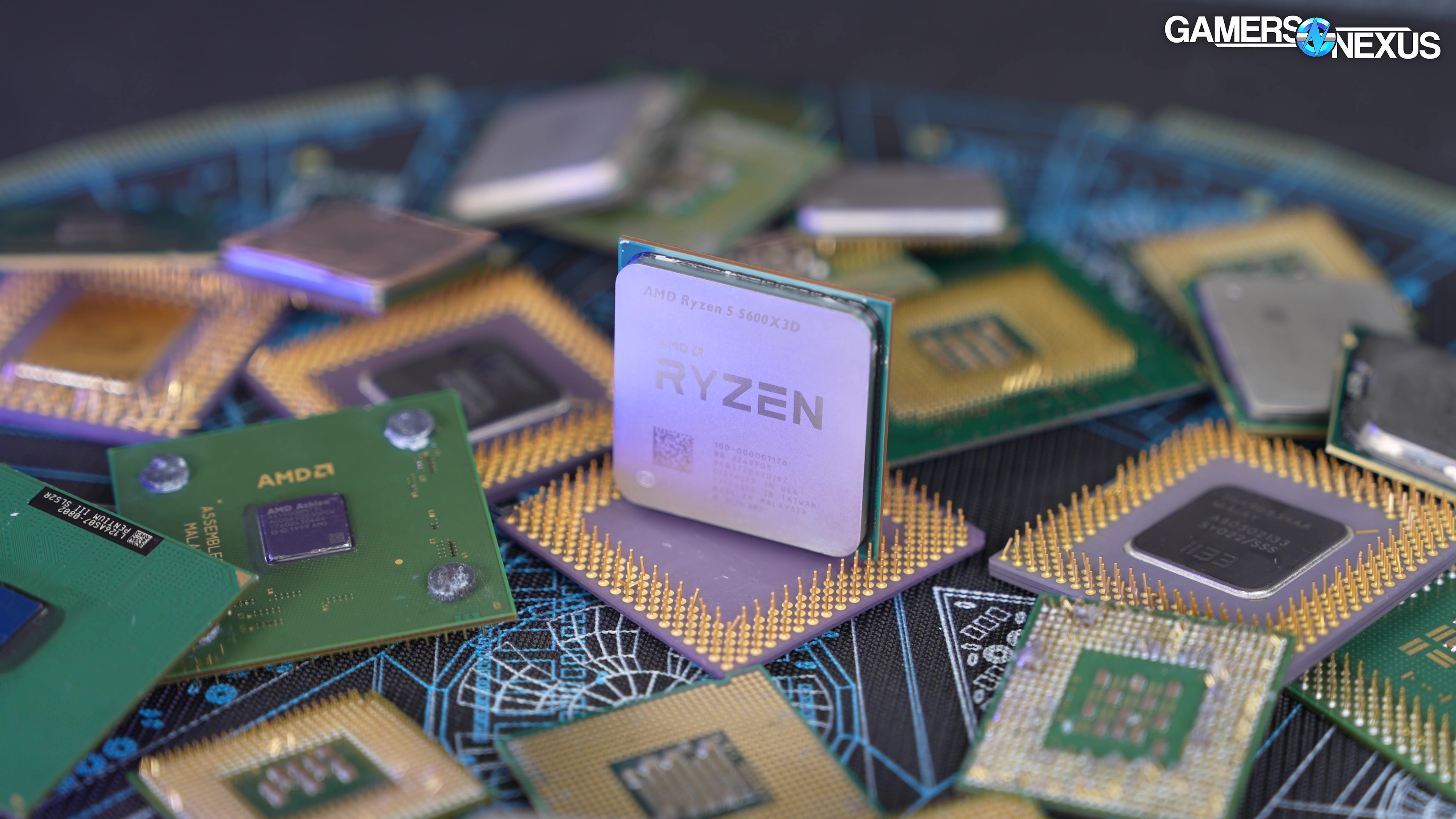
The AMD Ryzen 5 5600X3D is a Micro Center exclusive and is likely the last call for AM4 CPUs
The Highlights
- Being sold exclusively through Micro Center, supply for the AMD Ryzen 5 5600X3D is limited
- The CPU comes short of its advertised frequency by roughly 50MHz
- It is based on leftover or defective 5800X3D CPUs
- Original MSRP: $230
- Release Date: July 7, 2023

The AMD Ryzen 5 5600X3D is likely the last call for AM4 CPUs and, as we discussed in our previous news video, it’s an odd one. AMD didn’t have enough supply to make a global launch, but did have enough leftover or defective 5800X3D CPUs to convert them into something. So they made the 5600X3D and gave it to Micro Center to launch.
This launch was a total surprise to us and we had far less time than usual to get hands-on with the CPU, but we still put together a full review. This is a $230 part and, based on the original 5000 series numbers, that’d be an amazing price -- but the market has changed. In the time since the 5000 series was in our reviews, the R5 5600 non-X is now around $140 -- which is probably among the best budget CPUs available -- and the R5 5600X is about $170. The R7 5700X is about $200, making the 8-core option $30 cheaper than the new 6-core X3D CPU. AMD’s closest 7000 series CPU is the R5 7600, which costs around $215-$220, and the 7600X, which retails between $230-$250. This has become a dense market.
Credits
Test Lead, Host, Writing
Steve Burke
Testing
Patrick Lathan
Video Production
Vitalii Makhnogvets
Web Editing
Jimmy Thang
The main market for this thing will be drop-in upgrades. That makes price comparisons tough if they’re not within AM4, seeing as telling someone “but just upgrade to an entirely different motherboard and RAM” is a much bigger jump than “consider another AM4 alternative.” We’ll review with this in mind, but still provide comparisons to fully new platforms in case you’re not upgrading.
First up, some musings on the market: Now that we’re fresh on the pricing of last-generation parts, we’ve been wondering if maybe this is the way of the future for this market.
We’re seeing a new trend where older parts are either stocked enough or remain in production long enough for companies to slow releases of low-end parts in the current generation and instead continue selling last-generation parts as a new form of ‘low-end.’ We’ve seen this with the 30-series NVIDIA GPUs also, where the company has continued selling RTX 3060s and 3060 Tis even with the 4060 series launches.
This could just be the greedy over-purchasing that everyone did when expecting the pandemic sales to last for eternity, alternatively though, it also seems like a possible paradigm shift. The question is whether that’s a good thing: If the mid-range becomes the low-end one generation later, the economics may be better for companies. We’re not sure how it’d play out for consumers. Being one generation back isn’t necessarily bad if it also means you get to keep other cheap, older technology, like DDR4 (in the case of AM4), that pairs well with the budget market, but as we get past the DDR4-to-DDR5 switchover, it may be a worse outcome.
Anyway, that’s just something we thought of while writing this post. We haven’t put a ton of thought into it yet, but figured it’d be an interesting discussion point.
Specs & Overview
| AM4 X3D CPU Specs | 5600X3D | 5600X | 5800X3D |
| Cores/Threads | 6/12 | 6/12 | 8/16 |
| L2 Cache | 3MB | 3MB | 4MB |
| L3 Cache | 96MB | 32MB | 96MB |
| Base Frequency | 3.3GHz | 3.7GHz | 3.4GHz |
| Boost Frequency | 4.4GHz | 4.6GHz | 4.5GHz |
| TDP | 105W | 65W | 105W |
| OC Support | Limited | Full | Limited |
As for the 5600X3D, we covered the full specs and launch details in our aforementioned news video. The shortest possible version is this:
The 5600X3D is made of leftover or defective 5800X3D CPUs and is limited in supply. Micro Center is the only official retailer for it, which means it’s limited to specific areas of the US (not even just the US on the whole). Micro Center expects 3-6 months of availability for this part and informed us that AMD is only making one batch of these CPUs.
The CPU is a 6-core/12-thread 5600X with lower frequency and higher cache. Overall, you should expect this to encroach on the 5800X3D in gaming performance, but lose capability against the 5700X or 5800X in production applications due to the core deficit.
Now, this dropped in our laps with very little notice and after most of our team had scheduled vacations. We got as much done as we could and ran a few more CPUs through the charts to get comparisons. We’d like to have added the 13400F again and some other Intel CPUs, like the 13500, but we also weren't going to ask team members to pull extra hours without any notice whatsoever and after many had plans to travel. We still have a full review for you, we just want you to be aware of why the dataset is more limited. We’d typically have about 1 more full work week to process a review like this.
Anyway, let’s get started.

AMD Ryzen 5 5600X3D CPU Frequency
All-Core Frequency
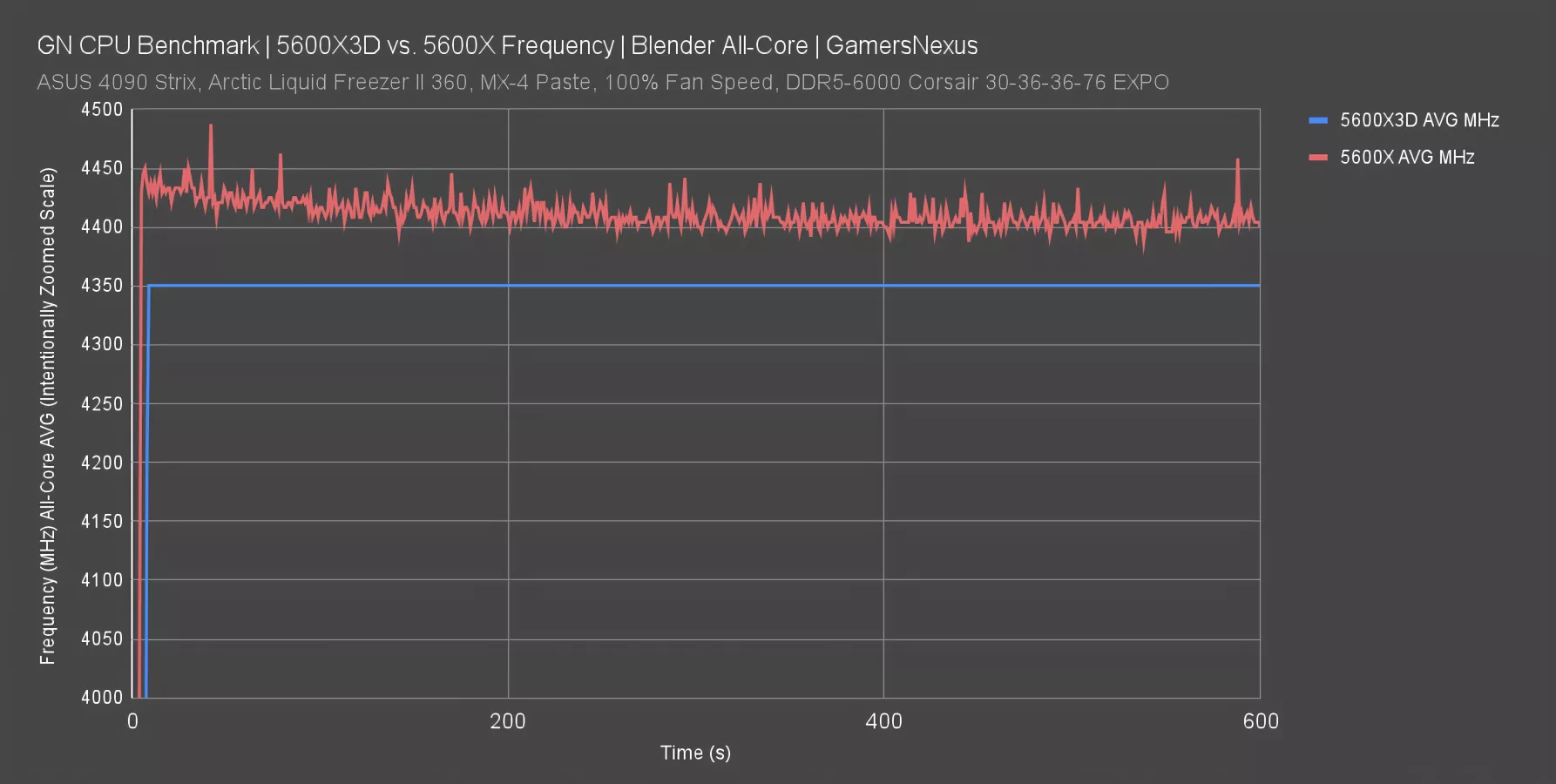
First, we’ll quickly look at a frequency plot versus the original R5 5600X to help give context to the performance figures.
In an all-core Blender workload, the R5 5600X3D plotted a perfectly flat line at 4350MHz. That’s with an all-core workload. Technically, that’s 50MHz below the advertised boost speed. What matters is whether it can hit that speed in a single-core scenario, which we’ll look at next.
The frequency behavior is much different when compared to the R5 5600X non-3D variant. The 5600X is more variable, falling gradually from a 4450MHz starting frequency down to about 4400MHz. That’s also below the technically advertised number, but that’s a result of two things: The first is that this is a first-round sample, and the second (more important) reason is that it’s an all-core load.
AMD R5 5600X3D CPU Frequency
Single-Core
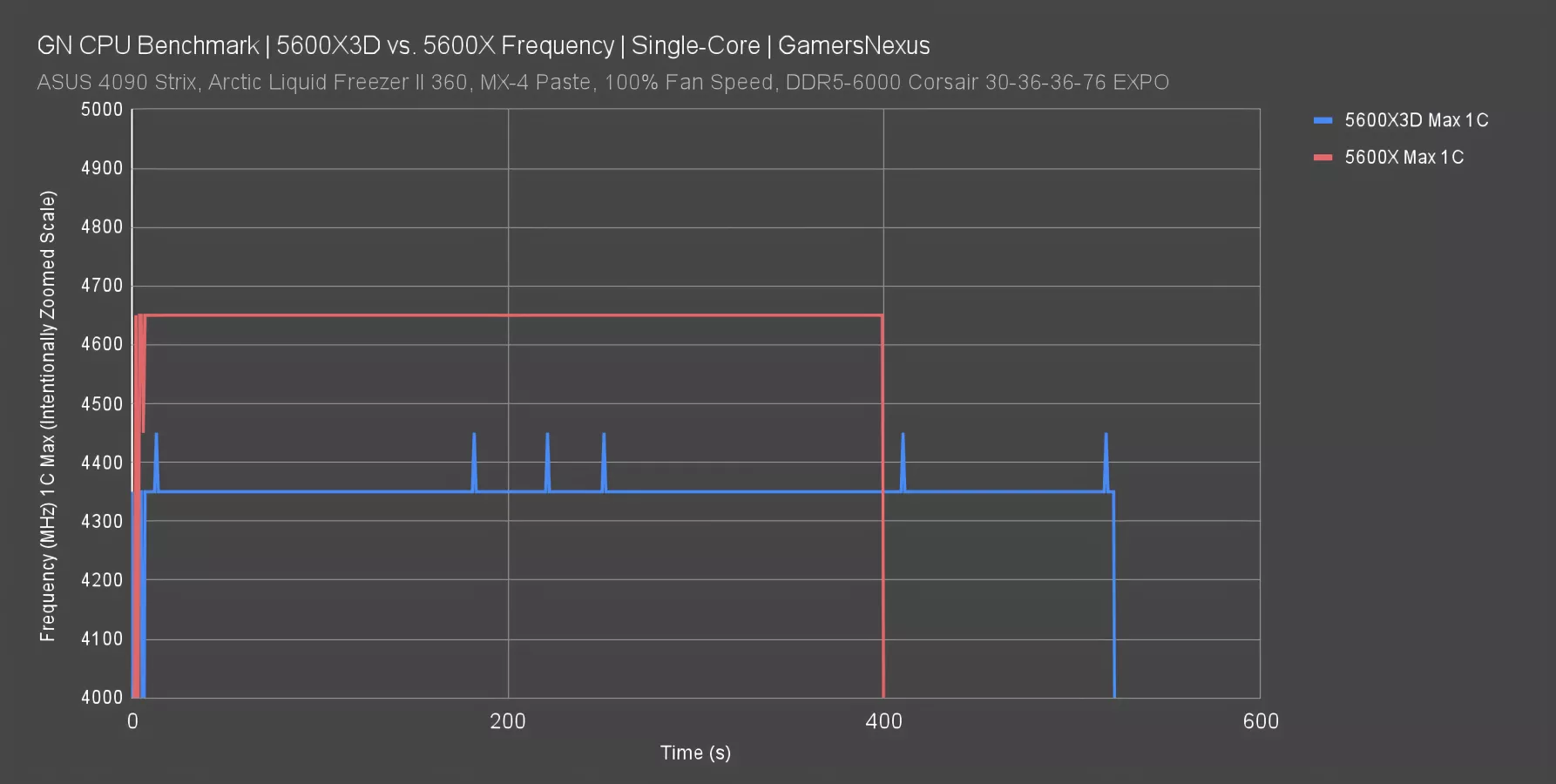
Here’s a frequency plot with a single-core workload.
In this one, the 5600X3D was still below the advertised 4.4GHz speeds. AMD isn’t hitting what it’s marketing. Being off by 50MHz is a pretty big gap. Now, technically, there are a few blips to 4400MHz or just past, but 6 plotted seconds of 500 doesn’t really qualify for hitting that marketing, in our opinion.
The 5600X held about 4650MHz for the entire test, which actually exceeds the marketing by 50MHz. Unfortunately for AMD, the two don’t average-out. They need to hit the marketing every single time.
Let’s look at some games.
R5 5600X3D Gaming Benchmarks
This next section will get into gaming benchmarks for the AMD R5 5600X3D CPU.
Shadow of the Tomb Raider
1080p/Medium

We’re going to start with the two games where we saw the most uplift in previous X3D tests. Tomb Raider is up first, another game where we’ve seen massive uplift from 3D V-Cache CPUs.
The 5600X3D’s 301FPS AVG pushed it into the company of Intel’s much more expensive 13900K and AMD’s own -- and more expensive 7700X at $300. The 5800X3D is 10% ahead of the 5600X3D, with only the modern 7800X3D (a $440 part now) ahead of that.
Compared to the cheaper options, the gain of the X3D CPU over the 5600X is a massive 39%. The benefit against the 5700X is similar, as our recent rerun of that CPU had it at 221FPS AVG.
Titles like this and Far Cry 6 are going to be the strongest cases for the 5600X3D since they allow it to encroach on the 5800X3D, but still have a significant gap from the far cheaper 5600 and 5600X CPUs.
Shadow of the Tomb Raider
1440p/Medium
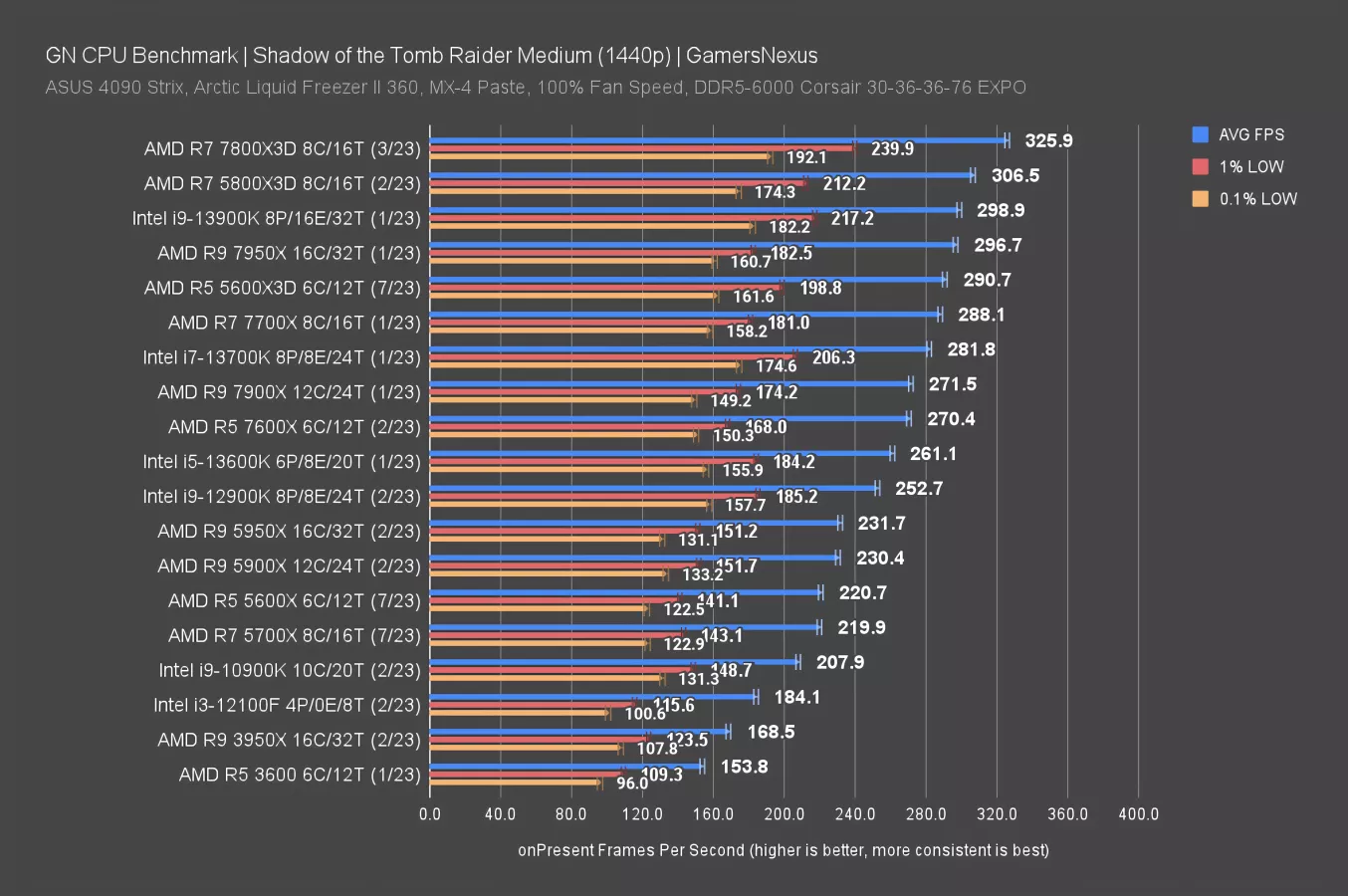
1440p promotes some movement of the top few parts, but overall, the 5600X3D still carves-out enough of an advantage to be worth considering even with a slight or inconsistent GPU bind.
Far Cry 6 CPU Benchmarks
1080p/High
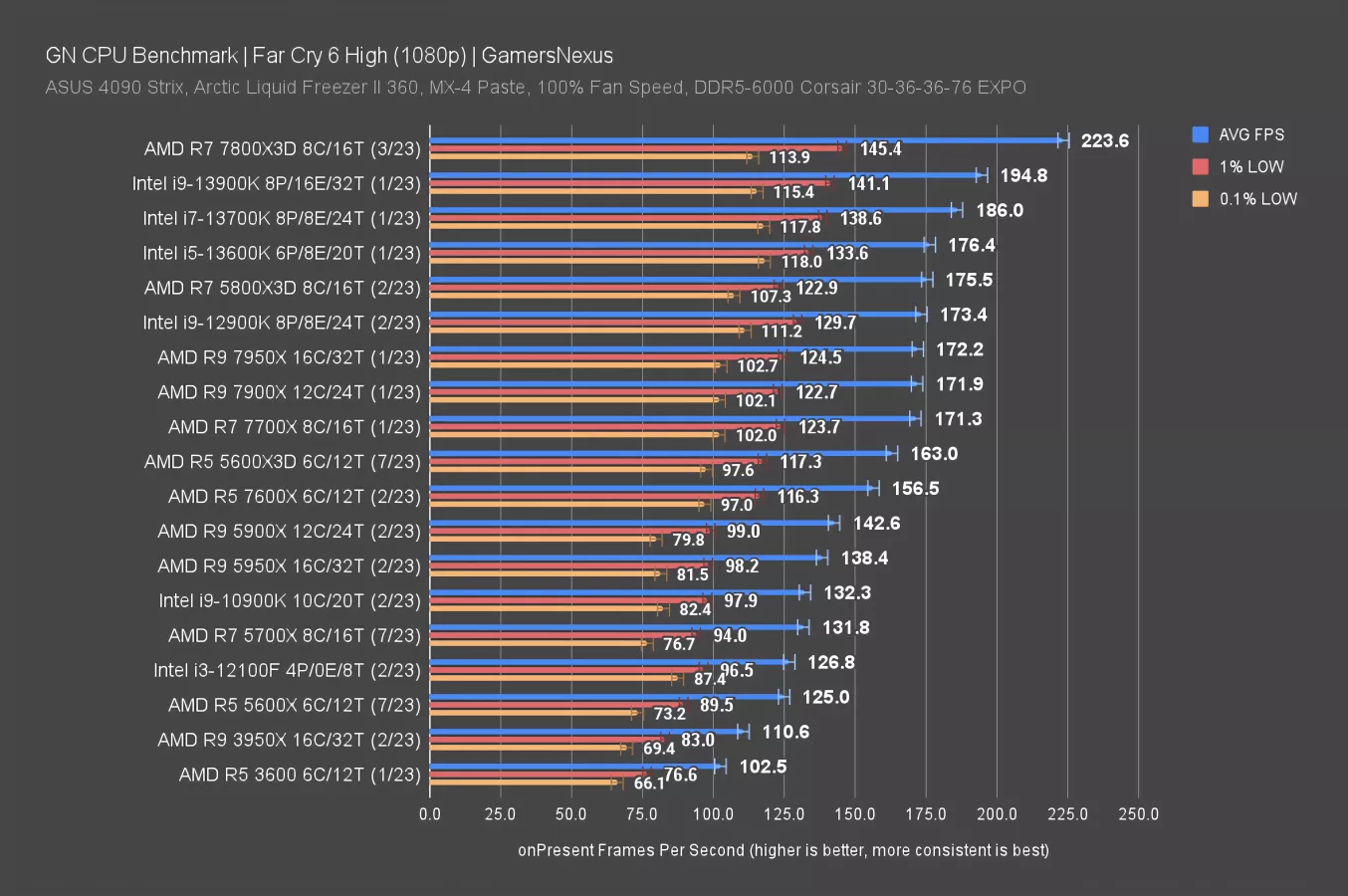
In Far Cry 6 at 1080p, the 5600X3D ran at 163FPS AVG, boosting it 30% over the 5600X-non-3D, with lows also higher. As we’ve seen before, the V-Cache works in the right scenarios. The 5700X’s 132FPS AVG allows it good value positioning -- basically where the original 5800X should have been -- but the 6-core X3D still outperforms it significantly here. The extra cores are less helpful in this game.
As for the 5800X3D, it’s still ahead of the 5600X3D and holds about an 8% lead. Lows are proportional. This makes the 5600X3D a seriously strong drop-in, end-of-life option for AM4. For gaming, the nearest AM5 price option is the 7600X, which is outperformed by the 5600X3D. Owners of existing builds would get one last gaming uplift with this without going up to the 5800X3D.
As mentioned early, we don’t have all of Intel’s current CPUs on here since this was a total surprise launch. The closest we have in our dataset right now is the 13600K, which ran at about 176FPS AVG. That’s ahead by 8% and is sold about $60-$70 higher than the 5600X3D.
1440p/High
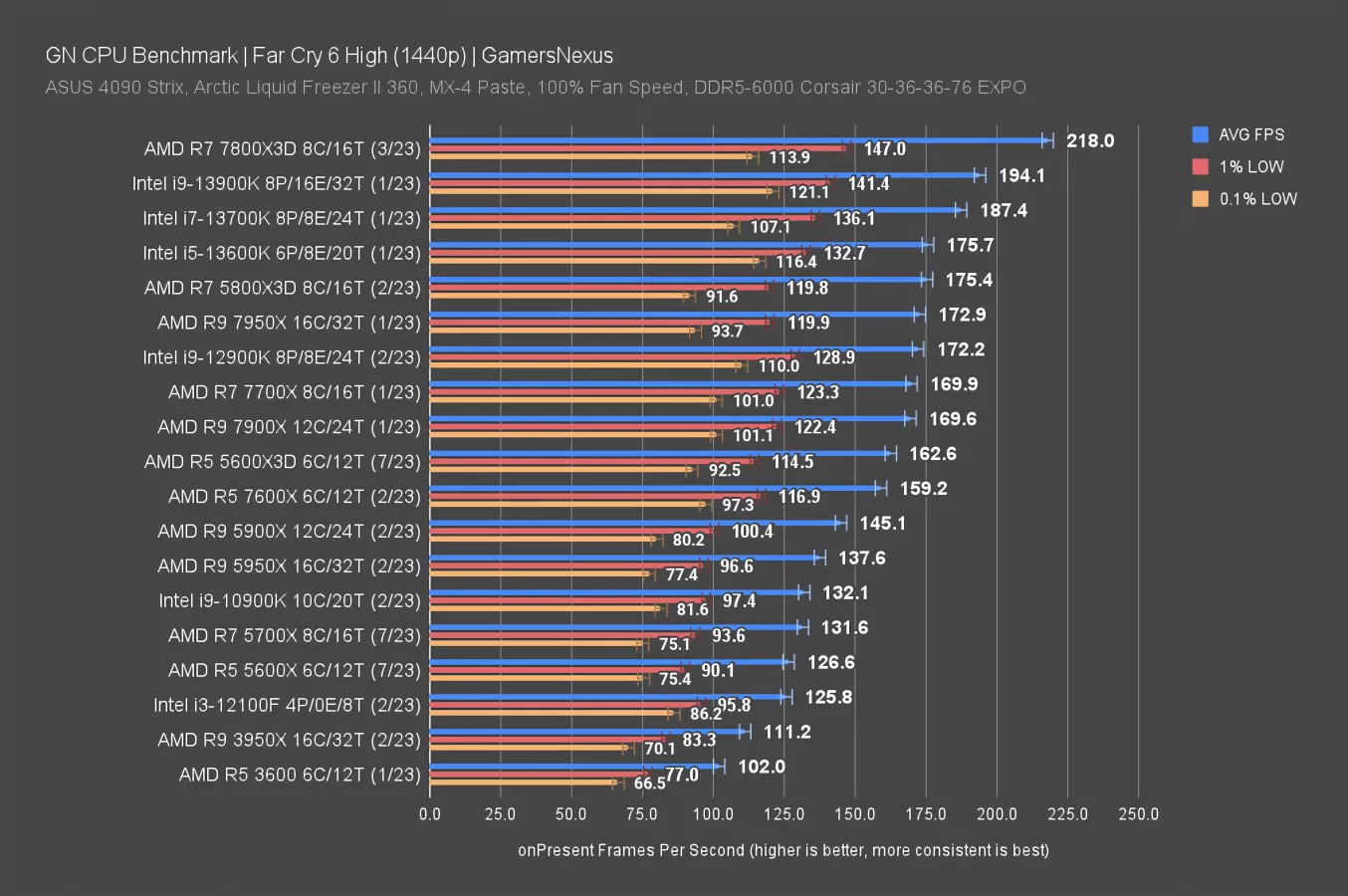
As for 1440p, the results were the same: We’re not GPU-bound, so it makes sense that there’s no change in the middle of the stack. Only the 7800X3D shows any change, and it’s not much of one.
FFXIV CPU Benchmarks
1080p/Maximum
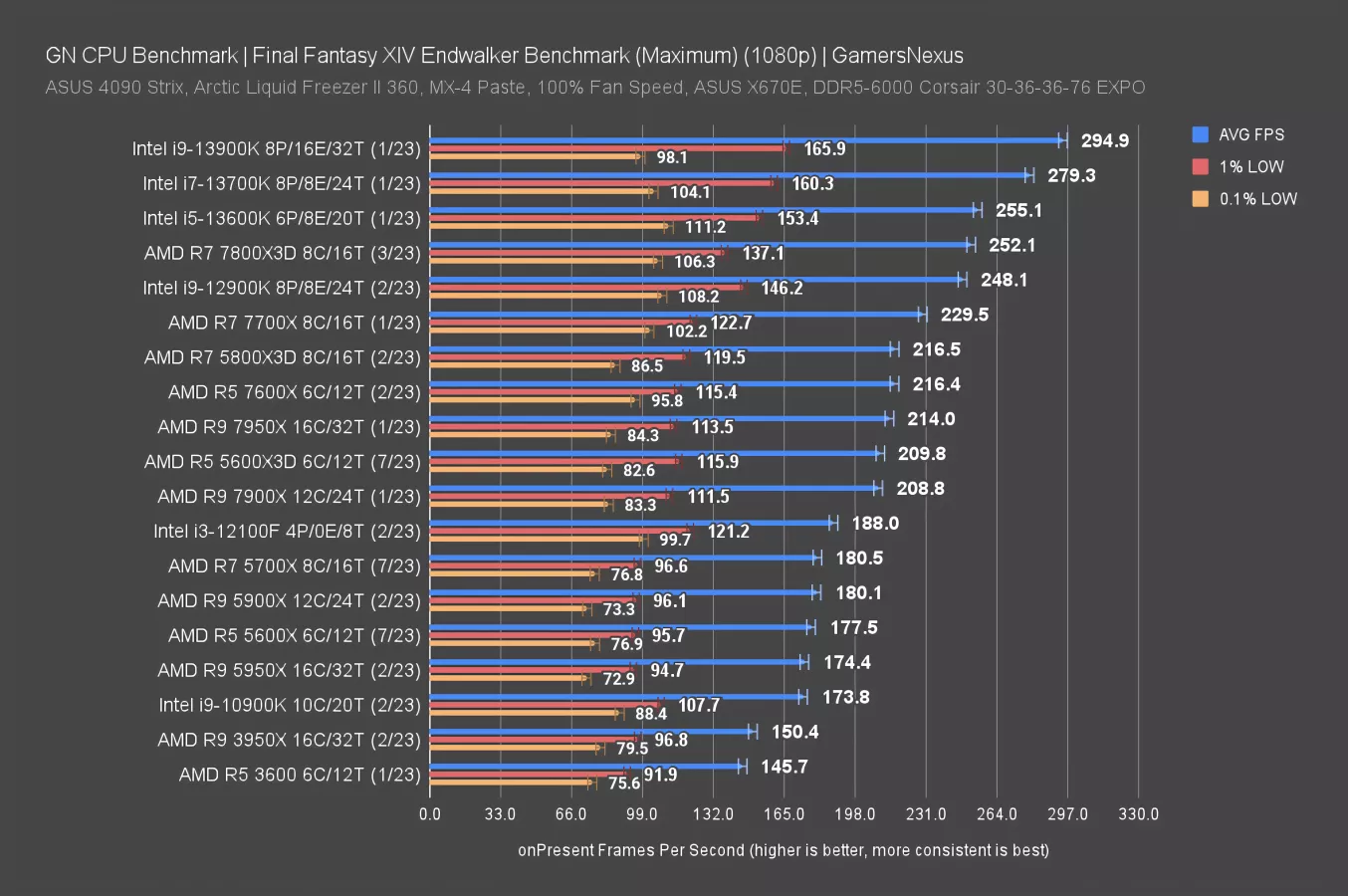
Final Fantasy 14 is up next, tested first at 1080p. This gives us a look at some of the best CPUs for FFXIV.
The gain isn’t as large here, but there’s still an improvement: The X3D part’s 210FPS AVG, 116FPS 1% low, and 83FPS 0.1% low allow it a lead over the 5600X in all 3 metrics. Frametime pacing hasn’t improved disproportionately, but in-step with the average. The boost is 18%, with the lead over the 5700X similar at 16%. Keep in mind that the 5600X’s $170 price means the X3D is about 35% more expensive right now. It’s late in the cycle, so remaining inventory is cheap. It’s a real gain, but you are paying for that performance.
Compared to the same-priced 7600X, there’s not much performance difference -- but the entire rest of the platform is cheaper or maybe even already in your possession. The 5800X3D is similarly not much of an improvement.
Intel’s 13600K holds about a 21% lead here, keeping its trend of generally higher performance in this game.
1440p/Maximum
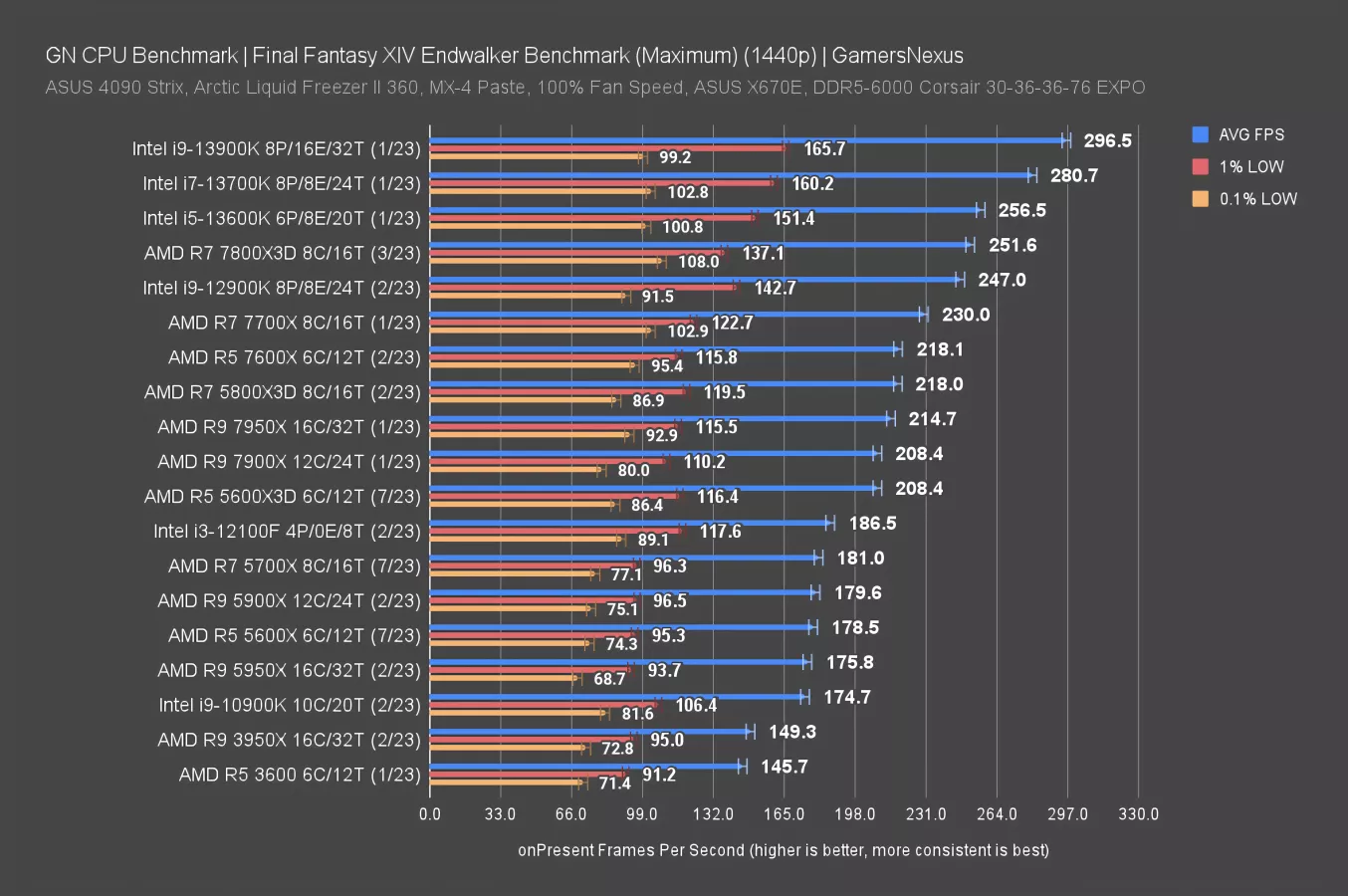
Like with Far Cry 6, there’s no change to the middle of the stack at 1440p. Actually, there’s basically no change other than some small movement: Even the 13900K remains about equal in performance. We’re fully CPU-bound.
Cyberpunk 2077 CPU Benchmarks
1080p/Medium-Custom

In Cyberpunk at 1080p, the 5600X3D posted a 22% uplift over the 5600X, with a slightly higher lead over the 5700X as a result of the higher base clock on the 5600X. The 5600X3D managed to outperform the 5900X and even the former flagship 10900K and is within striking distance of the 5800X3D. 3D V-Cache clearly still works even on a 6-core part -- and maybe even better, seeing as there’s no multi-chiplet complexity that we saw with the 7900X3D that we didn’t even bother to rerun for these charts.
We’ll skip 1440p. It was GPU-bound, so the 5800X3D and 5600X3D looked identical, as did most of the other high-end parts.
Counter-Strike: GO CPU Benchmarks
1080p/High-Custom
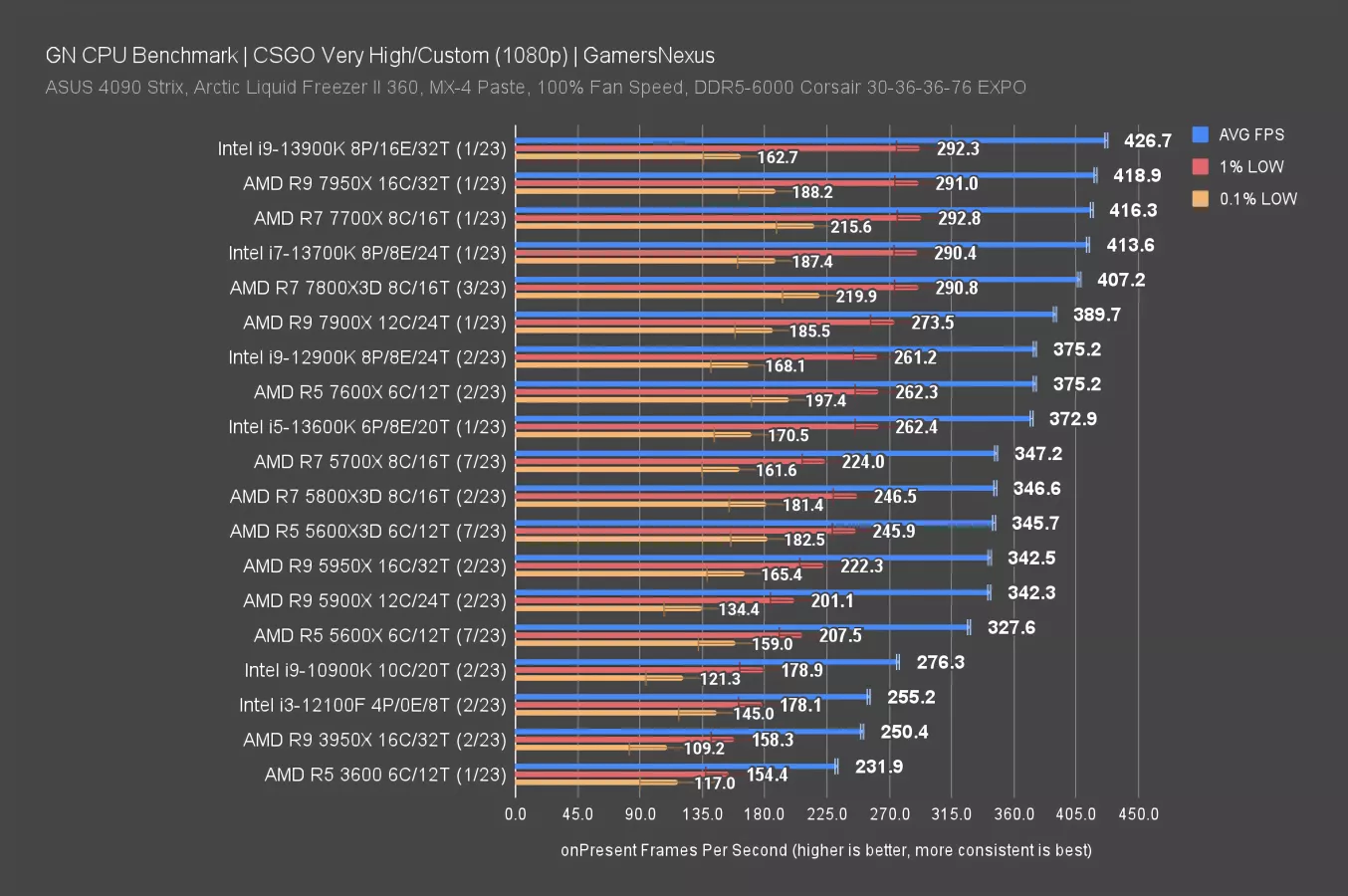
CS:GO is next. Tested at 1080p, CS:GO had the 5600X3D at 346FPS AVG. That’s tied with the 5800X3D; in fact, even the lows are tied. Between these, we had 8 test passes and the end result is about the same. That’s impressively consistent, but of course, means that the 5600X3D is taking from the 5800X3D’s viability in this kind of title. Overall though, that’s true of the 5600X and 5700X as well. The 5700X is $20-$30 cheaper than the 5600X3D and manages the same performance in our retests, albeit with marginally longer peak frametimes -- but not noticeably. That makes the 5700X a better deal here. The 5600X is significantly cheaper and only gives up a 5% lead to the X3D, so it's an even better value. We don’t have a 5600 non-X retest, but at $140, it’s also worth a serious consideration as a budget option.
Rainbow Six Siege CPU Comparison
1080p/Very High
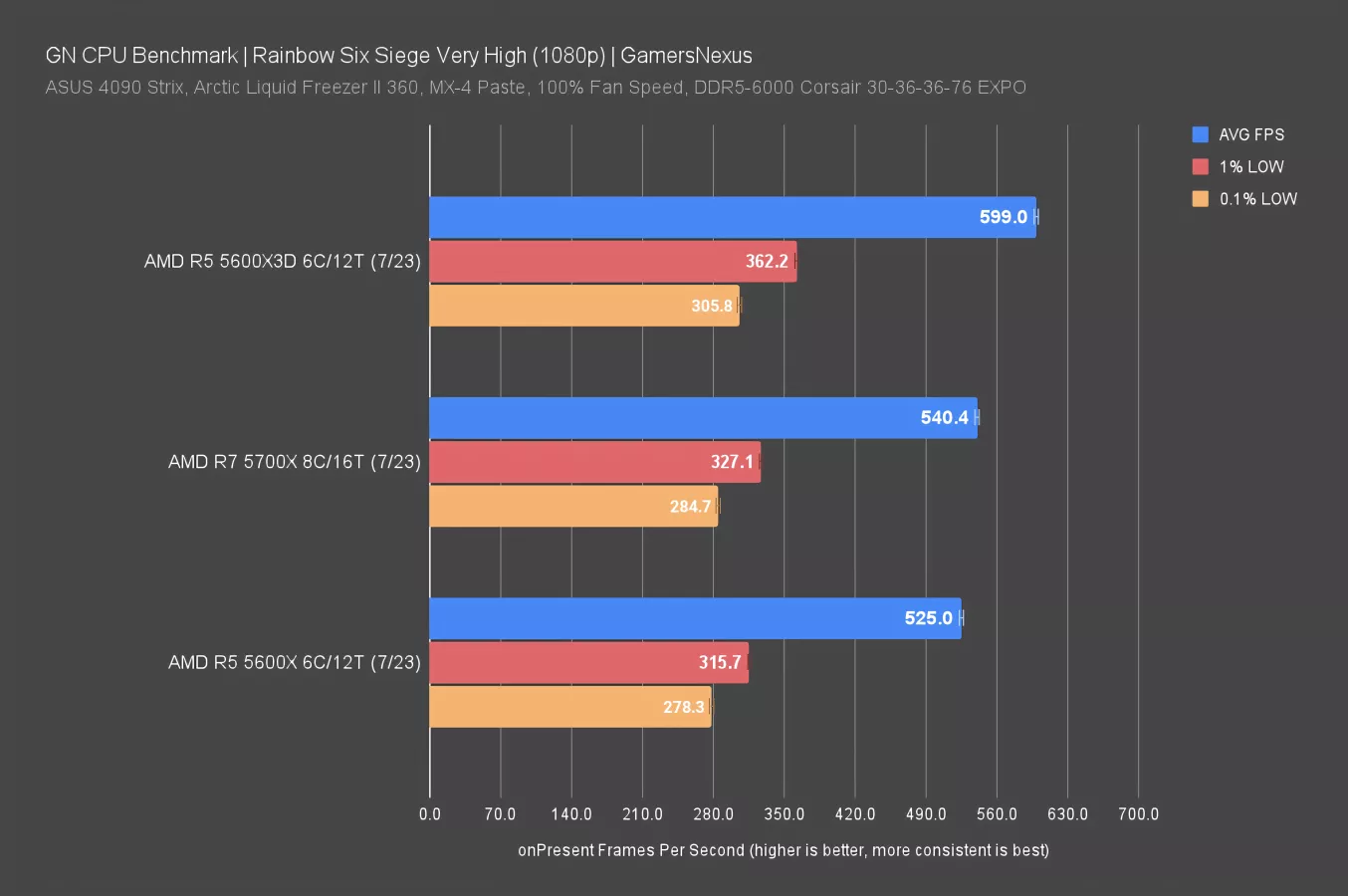
Rainbow Six Siege recently updated. The update improved performance, which is good overall, but is bad for us. It wiped out all of our comparable data because the numbers no longer match the game’s current patch. We reran just the 3 most relevant AM4 CPUs for this test. Normally, we wouldn’t bother with a chart that only has 3 parts on it, but it’s still interesting data.
The 5600X3D held about 600FPS AVG. For reference, in the pre-patch tests, the 13900K was over 800FPS -- there’s plenty of room for scale left here. That means the 5600X3D gained about 14% over the 5600X in average framerate performance, with lows also boosted. The lead over the 5700X is only 11% in this one.
Stellaris CPU Simulation Time Benchmarks
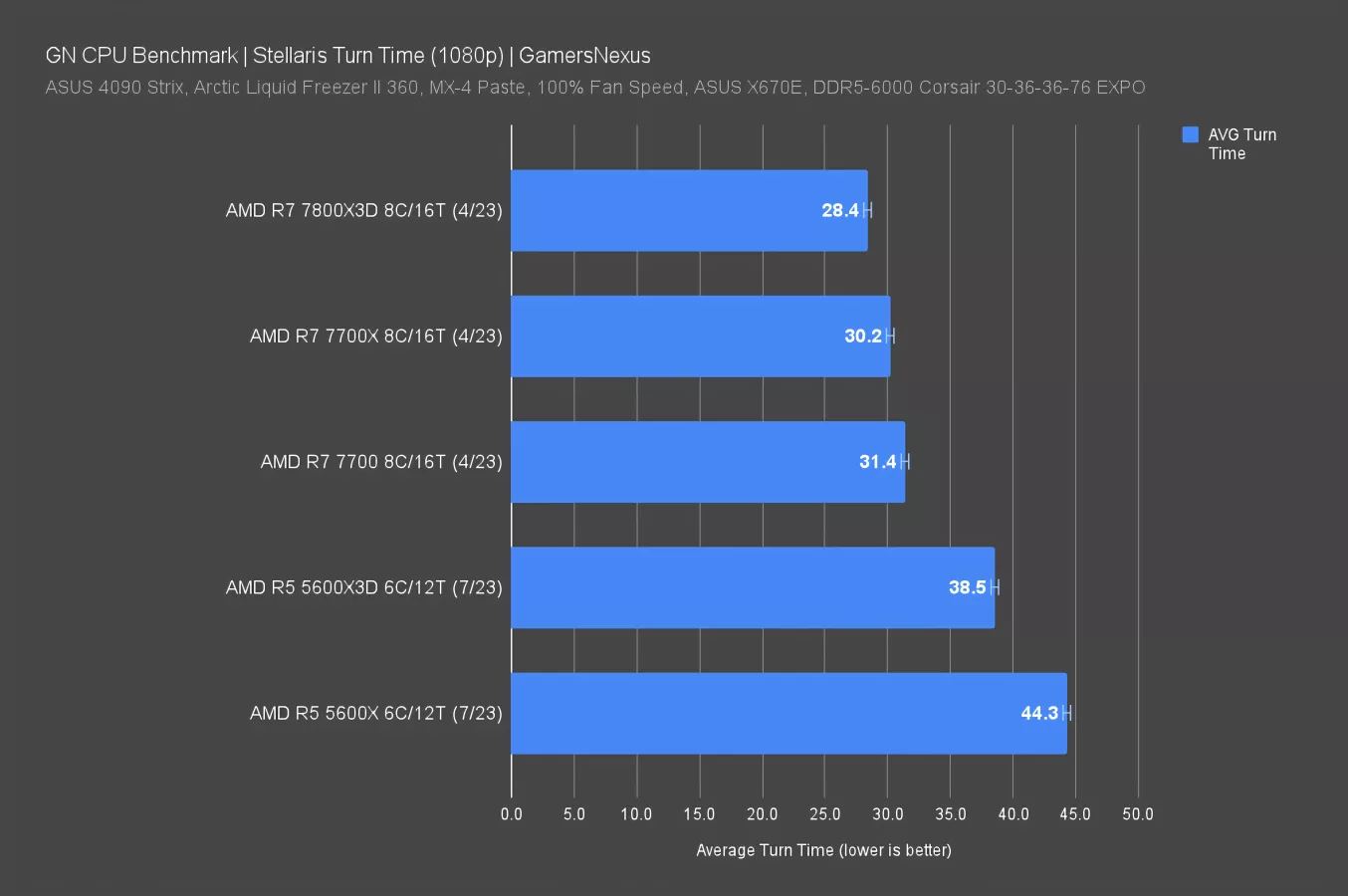
Up next is Stellaris. This was added by popular demand among our audience. We won’t be fully detailing the methodology today -- that’ll be our next major refresh of the test setup -- but the basics are that we’re averaging the turn time over multiple test passes. That’s as opposed to FPS. This is also new, so we only have 5 parts on this one -- all are AMD. We’ll add Intel to the next bench refresh.
The R7 7800X3D managed to pull ahead of everything else tested so far. The turn time reduction against the 7700X was 6%, or 10% reduced from the 7700. As for the 5600X3D, that one required 38.5 seconds per turn on average. It allows the 7800X3D a reduction of 26%, but manages a time reduction of 13% against the R5 5600X.
F1 2022 CPU Benchmarks
1080p/High
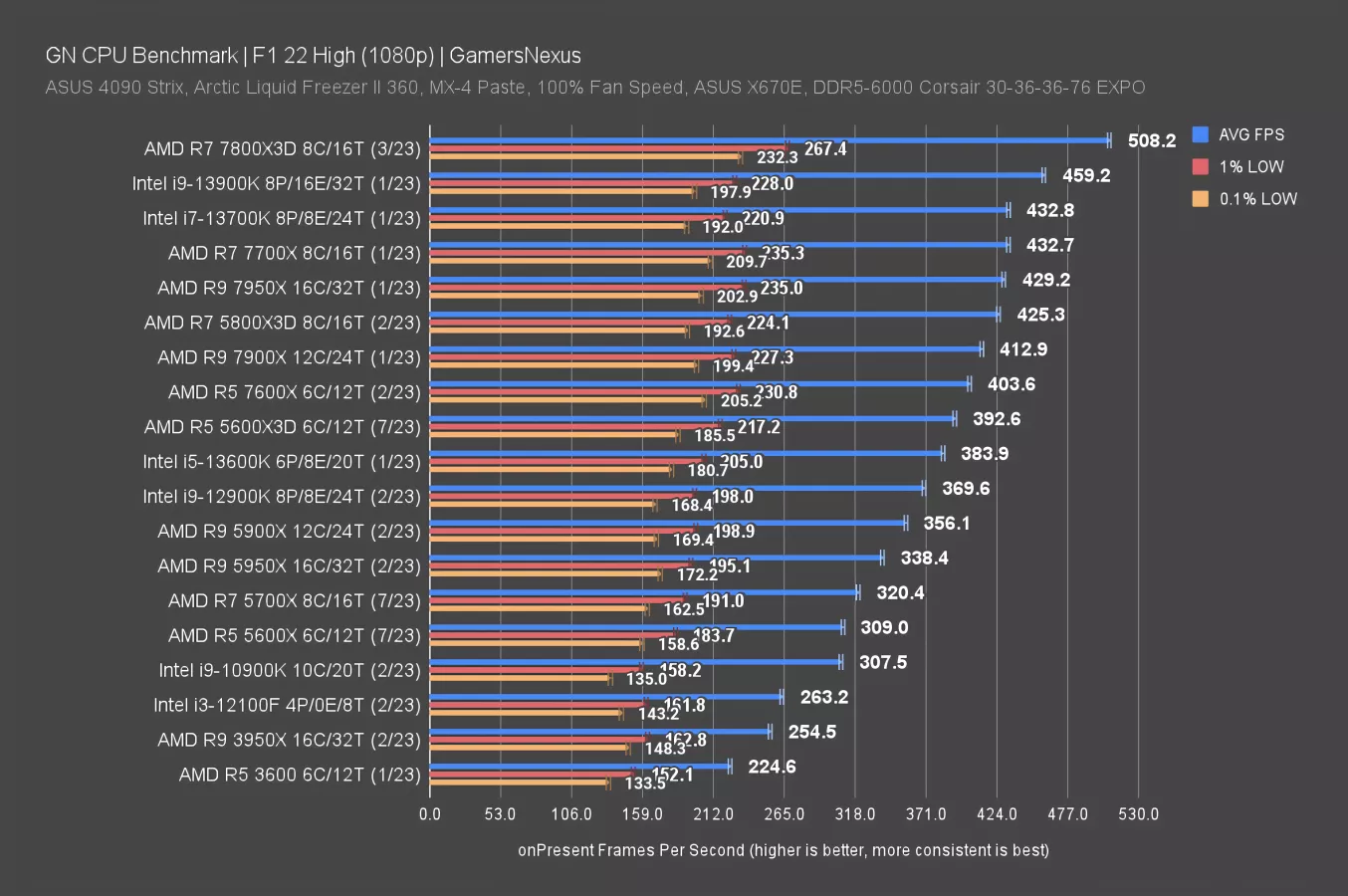
Now for F1 2022. In this one, the 5600X3D ran at 393FPS AVG, leading the 5600X by 27%. That’s another large lead over the namesake predecessor. That’s near the 5700X too, so the gain over the budget 8-core counterpart is similar.
Once again, the new X3D is near the 7600X -- close enough that the price wouldn’t be worth it if only for gaming performance. The 13600K ends up behind the 5600X3D this time, with the 13700K and 13900K contending against AMD’s impressive 7800X3D performance in this game.
Production Benchmarks
Now we’re moving on to production benchmarking, which includes applications like Adobe Premiere, Adobe Photoshop, Blender, and code compile testing. These scenarios are more core-bound, which means the 5600X3D will show its primary disadvantage as compared to the 5800X3D in these tests -- although technically, most of these X3D CPUs are worse than their same-part non-X3D counterparts in our production suite as a result of the reduced frequency.
Blender
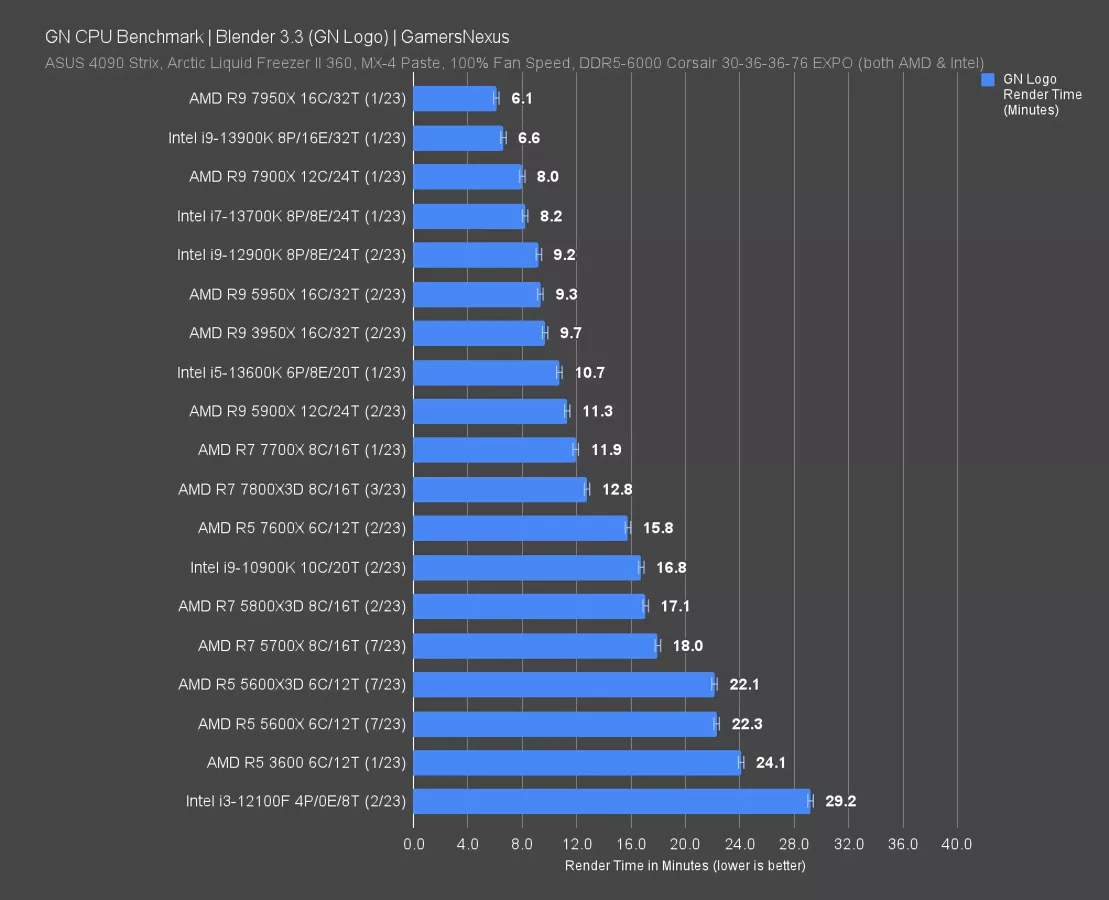
Blender is up first. In this one, loading the CPU cores with tiles to render, the 5600X3D required 22 minutes to complete the GN Logo scene. For reference, the 5800X3D took a little over 17 minutes, which is 22.6% faster. Although it’s not on here anymore, our last runs of the 5800X non-3D showed that it outperformed the 3D CPU marginally in most of these tests for its faster frequency.
The 7600X posts a large 29% time reduction in this one. Despite being the same core count, the architectural and frequency improvements benefit it in a big way. If you do more of a mix of core-intensive workstation use with your gaming, that’d be where the newer same core-count CPUs would do better. The Intel 13600K also posts a large advantage, landing at just 11 minutes to render.
Chromium Code Compile

Code compile of Chromium is next. For this one, the 5600X3D required 117 minutes to complete the compile. That’s almost identical to the 5600X, with the two within error. There was no benefit from the extra cache in this particular type of compile -- although there are workloads that can benefit from the extra cache.
The 5700X ended up a better value here, posting a 96-minute result from its core count increase. Intel’s 13600K halves the time required by pulling a 55-minute result. The X3D still does fine here, it’s just not the reason you’d buy it.
Adobe Premiere
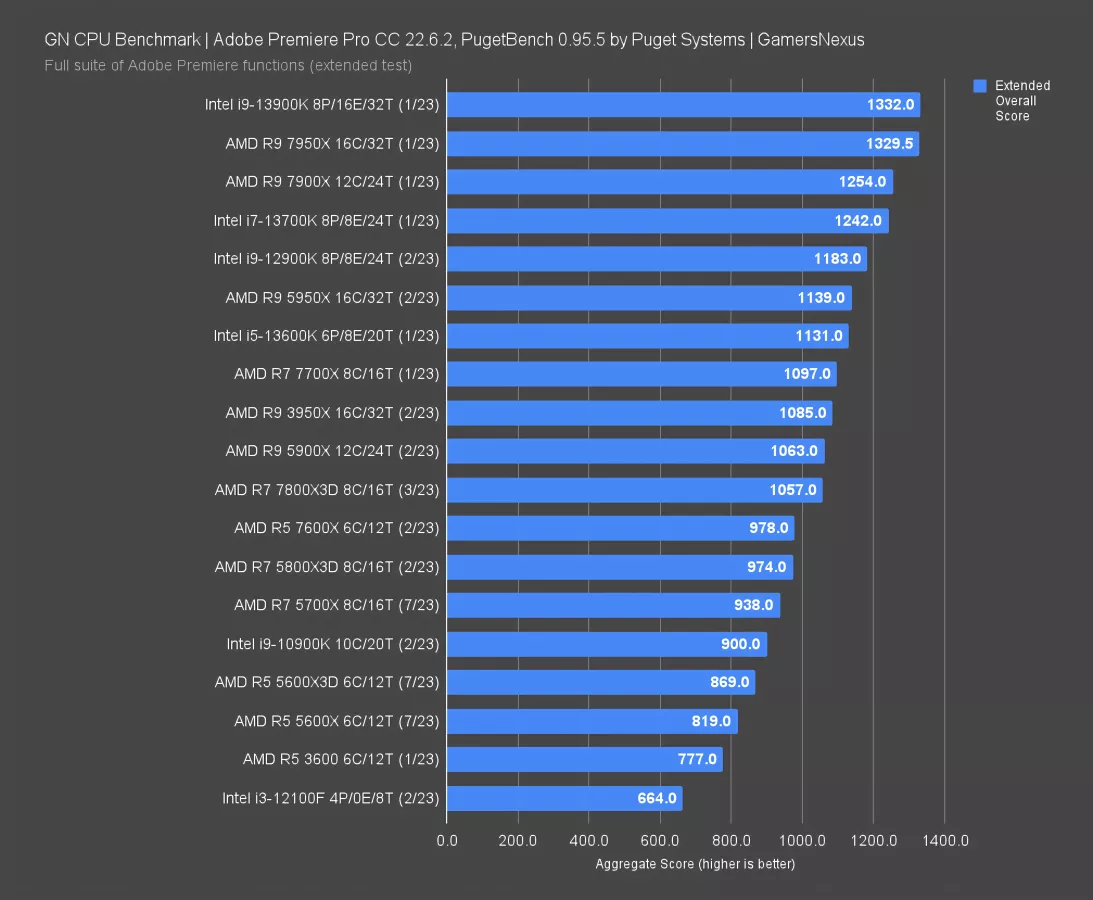
In Adobe Premiere, testing live playback, renders, filters, and other features, the 5600X3D scored 869 points in aggregate. That has it ahead of the 5600X by 50 points, or 6%. That’s a real lead -- it’s just not much of one or particularly worth it for the money. The 5700X manages an 8% lead over the 5600X3D while being cheaper, making it better value between only AMD options. Intel’s 13600K remains a competent performer -- as do the 13500 and 13400, although we haven’t rerun them recently -- and lands in the top half of the chart.
Adobe Photoshop
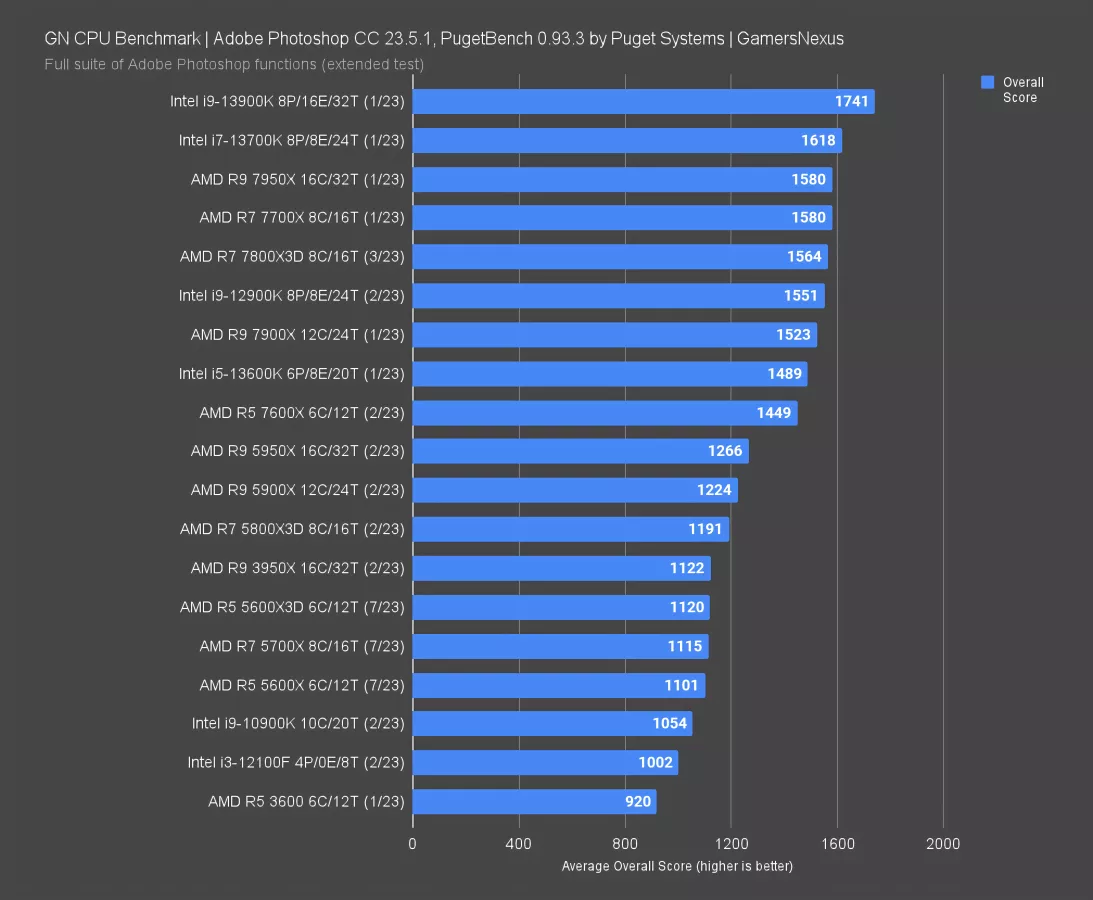
In Photoshop, the R5 5600X3D scored 1120 points in aggregate by using a similar approach to the Premiere test suite, both with Puget’s tools. That result has the 5600X3D technically ahead of the 5700X, but realistically, they’re the same. The lead over the 5600 is outside of error and is about 1.7%, but nothing meaningful. That’s consistent with the other workstation tests. Intel’s more expensive 13600K is significantly ahead at 1489 points, or a 33% lead. The 5800X3D is ahead of the 5600X3D as well, establishing the core advantage.
Power Consumption
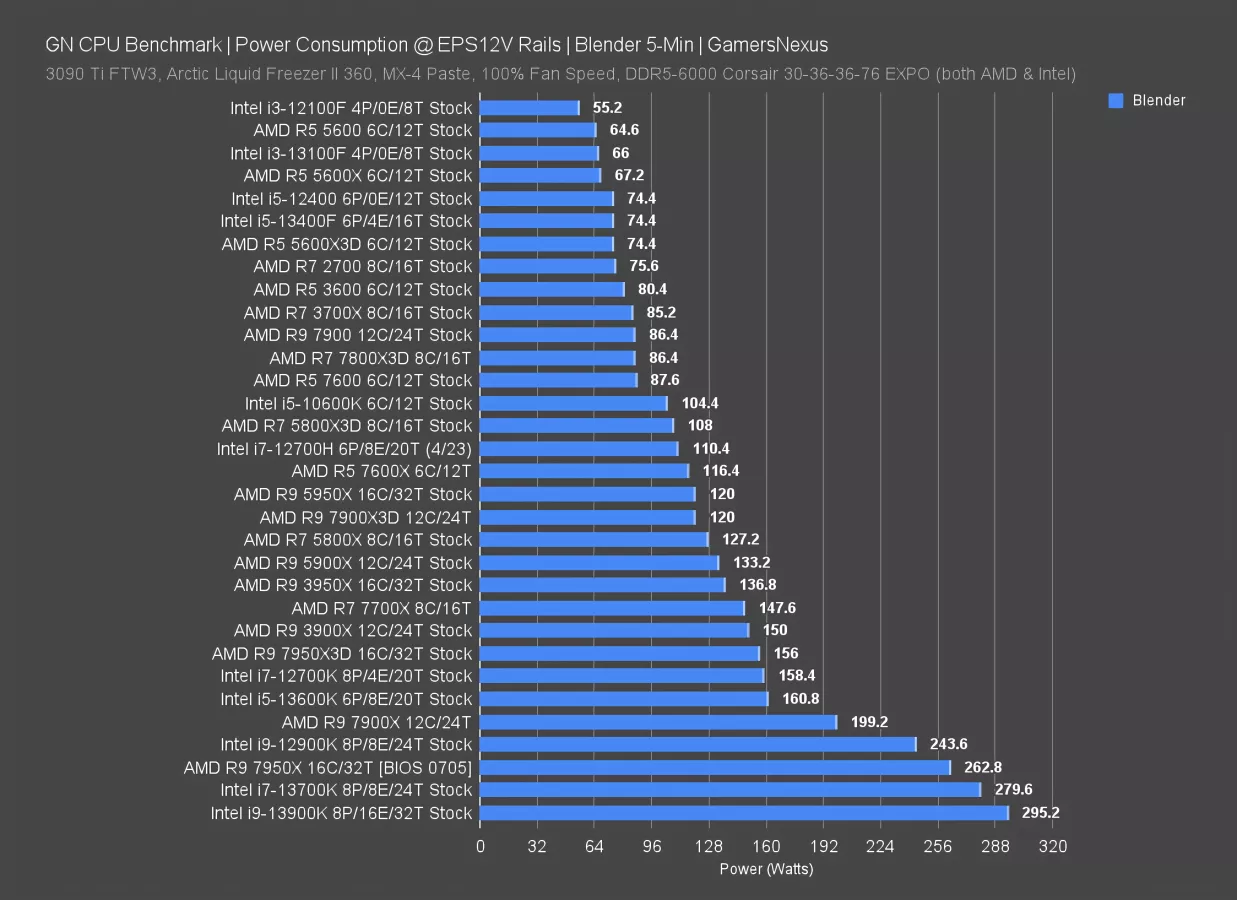
Here’s a quick look at CPU power consumption. In this test, the R5 5600X3D pulled 74W in an all-core Blender workload. That has it the same as the Intel 13400F and insignificantly more than the 5600X. As a reminder, the 5600X was the most efficient CPU we’d tested back when it launched, and so that translates well to the X3D: Keeping roughly the same power consumption but increasing gaming performance is an uplift overall.
Conclusion

The 5600X3D definitely does what it’s supposed to: As we’ve seen with past X3D CPUs, it maintains similar power characteristics to the non-3D variant, but with higher performance in gaming, which means better overall efficiency. This is likely an upgrade for people. The biggest competition for AMD right now is its own parts, especially for the upgrade market seeing as how jamming an Intel CPU into an AMD socket isn’t recommended.
The R7 5700X at $200-$210 is mostly worth considering if you want to save more money or if you mix in a heavier dosage of workstation applications. You can find one of those here. Overall though, the 5600X3D does outperform it in games.
The lead over the 5600X is anywhere from 10% to 40%. The upper end of that is impressive and enough to consider. The 5600X at $170 is a good price though, and for ultra-budget buyers, the 5600 also makes sense as an upgrade from an older generation AMD CPU.

Intel’s closest competition would be the 13400 at $230. We have charts for that in our 13400 review and you could extrapolate the comparison with good accuracy.
AMD’s Ryzen 7000 parts are mostly defeated by the 5600X3D in price-for-price comparisons except for in workstation applications.
AMD also misses the advertised frequency by 50MHz, which is unfortunate, but not a deal-breaker. We just need to stay on them about that so they don’t slide backwards.